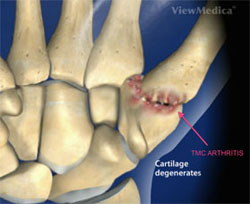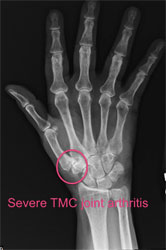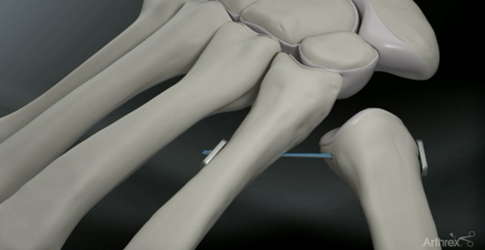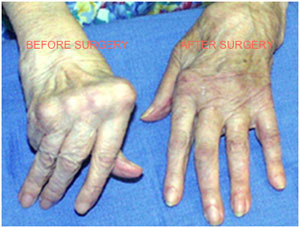Osteoarthritis of the Hand: What Is It And How To Treat It
What is Osteoarthritis of the Hand?
 Osteoarthritis of the hand is a common condition causing pain, stiffness, and swelling in the joints of the hands and the fingers. The hand is comprised of five metacarpal bones and 14 phalangeal, or finger, bones. These long, skinny bones have cartilage on their tips where they articulate with the next bone. This articular cartilage acts as a cushion and an anchor to cells which secrete synovial fluid. Synovial fluid acts as a lubricant to facilitate movement of the bones at the joint. In osteoarthritis of the hand, the articular cartilage is damaged, and has little ability to repair itself. With continued use of the joint, wear and tear of the damaged cartilage occurs. This may progress until all of the cartilage in the joint has worn away and the two bony surfaces of the joint are touching directly without a protective cartilage cushion. In an attempt to heal itself, the joint secretes more synovial fluid leading to swelling, and bone spurs may form.
Osteoarthritis of the hand is a common condition causing pain, stiffness, and swelling in the joints of the hands and the fingers. The hand is comprised of five metacarpal bones and 14 phalangeal, or finger, bones. These long, skinny bones have cartilage on their tips where they articulate with the next bone. This articular cartilage acts as a cushion and an anchor to cells which secrete synovial fluid. Synovial fluid acts as a lubricant to facilitate movement of the bones at the joint. In osteoarthritis of the hand, the articular cartilage is damaged, and has little ability to repair itself. With continued use of the joint, wear and tear of the damaged cartilage occurs. This may progress until all of the cartilage in the joint has worn away and the two bony surfaces of the joint are touching directly without a protective cartilage cushion. In an attempt to heal itself, the joint secretes more synovial fluid leading to swelling, and bone spurs may form.
What causes Osteoarthritis of the Hand?
Advanced age is a known risk factor for osteoarthritis of the hand. Occupations or hobbies which involve repeated wear and tear on the finger joints is another cause. Younger people may be affected due to a traumatic injury to the hand or a congenital abnormality of the joint.
What are the symptoms of Osteoarthritis of the Hand?
Pain is the most common presenting symptom of osteoarthritis of the hand. It usually progresses in intensity over time. In the beginning the pain may occur only with activity and be relieved by rest. Late in the disease, the pain may be a constant, dull ache.
Stiffness of the joint is also a common complaint. This is due to the excess synovial fluid that builds up in the joint. Stiffness is usually worse in the morning or after a long period of inactivity.
The joints of the hand may become widened, enlarged, and deformed. Bony lumps, called nodes, may grow on the finger joints. Heberden’s nodes occur on the joint closest to the fingertip, and Bouchard’s nodes can be found on the middle finger joint. Digital Mucoid Cysts, which are a subtype of Ganglion Cyst, may occur on the joint closest to the fingertip as well.
How is Osteoarthritis of the Hand Diagnosed?
 A thorough history and physical examination are essential to the diagnosis of osteoarthritis of the hand. As mentioned above, pain, stiffness, and deformities of the joint may be elicited in the physical exam. It is important to differentiate between osteoarthritis and other issues that cause pain, such as carpal tunnel syndrome, before starting treatment. Blood tests will also be used to rule out other forms of arthritis in the hands such as rheumatoid arthritis, gout, and septic arthritis. Rarely, needle aspiration of the fluid of in the joint may be performed to rule out other causes of arthritis.
A thorough history and physical examination are essential to the diagnosis of osteoarthritis of the hand. As mentioned above, pain, stiffness, and deformities of the joint may be elicited in the physical exam. It is important to differentiate between osteoarthritis and other issues that cause pain, such as carpal tunnel syndrome, before starting treatment. Blood tests will also be used to rule out other forms of arthritis in the hands such as rheumatoid arthritis, gout, and septic arthritis. Rarely, needle aspiration of the fluid of in the joint may be performed to rule out other causes of arthritis.
Imaging studies will be performed to examine the joint itself. Plain X rays can show bone spurs, loss of cartilage, and damage to the bones. Often, the severity of a patient’s symptoms and the findings on the X ray may not correlate. MRI can then be used to assess early changes of osteoarthritis that may not show up on a traditional X ray.
How is Osteoarthritis of the Hand Treated?
Osteoarthritis of the hand can be treated non-surgically or surgically depending on the severity of symptoms and disability caused by the illness.
Non-Surgical
For mild to moderate cases, pain control can be achieved through oral medications such as acetaminophen or NSAIDs like ibuprofen. Exercise or physical therapy may be prescribed to maintain joint range of motion. In some cases, intra-articular injection of steroid medications, like Celestone, may be helpful. An Occupational Therapist may be consulted to teach necessary lifestyle modifications.
Surgical
If the pain of osteoarthritis in an isolated finger joint becomes severe and debilitating, surgery may be needed. In a procedure called Finger Joint Fusion the finger is placed in a permanently extended position to prevent pain. With Finger Joint Fusion, the bone tips are surgically filed and shaped, allowing them to directly fit together, like two pieces of a puzzle. A surgical pin or screw is used to hold the two bones in place during the healing process. As bone is a dynamic structure, it will resorb and rebuild, naturally fusing the joint together over a period of six to eight weeks. During this time the finger is splinted to prevent motion. The splint is removed once it is confirmed that fusion is complete.


How can Dr. Knight help you with arthritis of the hand?
Dr. Knight has extensive experience in the treatment of arthritis of the hand. He will first confirm the diagnosis then provide conservative treatment to rapidly relieve or reduce your symptoms. In severe cases where you have pain with activities of daily living or pain at rest unrelieved with conservative care, surgery may be necessary. Based on your lifestyle and functional demands he will look at various options with you.
Dr. Knight is one of the premier hand surgeons in Dallas. We invite you to contact us today, or visit him at our Southlake office or Dallas office.
Osteoarthritis of the Hand Fact Sheet
| How do people get arthritis in their hands? | Arthritis of the hand can be caused by age, repetitive motion, and often trauma in younger sufferers. |
| Can I treat my hand arthritis at home? | The most effective home treatments for Arhthritis of the hand are physical therapy, rest, and icing |
| What medications are effective at combating or treating arthritis of the hand? | Medications used to treat arthritis include acetaminophen, NSAIDs, and steroid injections |
| Is hand arthritis something I'm stuck with for life? | If it is not treated effectively and steps taken to avoid getting worse, yes, it can be. |
| What are some treatments for hand arthritis? | Conservative medications, or surgery consisting of joint fusion |
| Can food affect Arthritis of the Hand? | Yes, certain food increase the risk of inflammation, which can exacerbate arthritis |
Frequently asked Questions:
How do I know if I am developing Arthritis of the Hand?
If you’re developing arthritis, pain is going to be the first and most noticeable sign. Along with pain, your joints will begin to stiffen and swell as a result of excess synovial fluid building up within the joints themselves. At later stages, nodules and lumps of bone may begin to appear at the joint sites, but this will all be preceded by the pain and swelling, so you will know long before the nodules appear.
Can what I eat affect the development of Arthritis?
While the relationship between food and particular conditions is often no more than an old wives’ tale, in the case of arthritis there are actual clinical relationships between the foods we eat and the development of arthritis. Arthritis is an inflammatory condition, and one of the most common effects that some foods can have on the body is to cause inflammation. When you ingest foods that cause this, it can exacerbate the symptoms of already underlying arthritis. High fat foods, such as fried and processed fast food, refined carbohydrates and refined sugar can lead to tissue inflammation and heighten the pain and other symptoms of arthritis, and are best avoided.
Do I have to have surgery to fix Arthritis?
Surgery is not explicitly necessary as the sole method of remedying arthritis of the hand, but once the condition passes a certain stage of inflammation, there is little else that can be done to reverse the swelling, pain, and debilitation. Once a patient begins to develop the bony nodules discussed above, surgery is the only real option, because without it the fingers will become essentially unusable, and the bone will calcify into place, so it is important to deal with the symptoms of arthritis as soon as possible to avoid these complications.
How can I keep my arthritis from getting worse?
Unfortunately, osteoarthritis is not an illness that can be treated by ignoring it, and even if you take your diet into control, regularly exercise and massage your affected hands, medical treatment is going to be necessary to address it sooner or later.
Videos
Animated Videos
Surgical Video
Note: The following videos contain graphic images.
(817) 382-6789
Disclaimer
HandAndWristInstitute.com does not offer medical advice. The information presented here is offered for informational purposes only. Read Disclaimer

























